Gloster Gladiator Video - Documentary clip
|
|
Gloster Gladiator
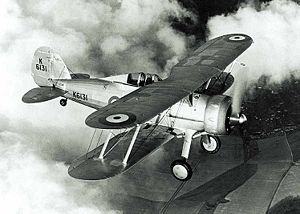
Picture - Gloster Gladiator in pre-war RAF markings
Role: Fighter
Manufacturer: Gloster Aircraft Company, Ltd.
Designed by: Henry Phillip Folland
First flight: 12 September 1934
Introduced: 1937
Retired: 1953 (Portugal)
Primary users: Royal Air Force
Fleet Air Arm
Chinese Nationalist Air Force
Finnish Air Force
Norwegian Army Air Service
Number built: 747
Developed from: Gloster Gauntlet
The Gloster Gladiator (or Gloster SS.37) was a British-built biplane fighter. It was used by the Royal Air Force (RAF) and the Royal Navy (as the Sea Gladiator variant) and was exported to a number of other air forces during the late 1930s. It was the RAF's last biplane fighter aircraft and was rendered obsolete by newer monoplane designs even as it was being introduced. Though often pitted against more formidable foes during the early days of the Second World War, it acquitted itself reasonably well in combat.
The Gladiator saw action in almost all theatres during the Second World War, with a large number of air forces, some of them on the Axis side. The RAF used it in France, Norway, Greece, the defence of Malta, and the brief Anglo-Iraqi War (in which the Royal Iraqi Air Force was similarly equipped). Other countries deploying the Gladiator included China against Japan, beginning in 1938; Finland (along with Swedish volunteers) against the Soviet Union in the Winter War and the Continuation War; and Norway, Belgium, and Greece resisting Axis invasion of their respective lands.
South African Marmaduke "Pat" Pattle was the top Gladiator ace with 15 victories over Italian aircraft.
Design and development
The Gladiator was developed from the Gloster Gauntlet as a private venture by H.P. Folland's team at Gloster to meet Specification F.7/30. F.7/30 demanded a top speed of at least 250 mph (400 km/h) and an armament of four machine-guns, while encouraging the use of the new Rolls-Royce Goshawk evaporatively cooled engine, which was used by most of the competitors for the specification. This engine proved, however to be unreliable, and Folland realised that the Gauntlet could be quickly revised to meet the specification. To reduce drag, the new fighter, the SS.37, had single-bay wings instead of the two-bay wings of the Gauntlet, and was fitted with a cantilever main undercarriage incorporating internally spung wheels.
The SS.37 first flew on 12 September 1934, powered by a 530 hp (395 kW) Bristol Mercury VIS engine, but was soon fitted with a more powerful engine, reaching 242 mph (390 km/h) while carrying the required four machine guns (two synchronised Vickers guns in the fuselage and two Lewis guns under the lower wing). On 3 April 1935, the Royal Air Force commenced operational evaluations, while Gloster planned a further improved version with a 830 hp 619 kW Mercury IX and a fully enclosed cockpit.
Three months later, a first order was placed for 23 aircraft to Specification F.14/35, with the aircraft named "Gloster Gladiator", followed by an order of 180 in September. The first version, the Mk I, was delivered from July 1936, becoming operational in January 1937. The Mk II soon followed, the main differences being a slightly more powerful Mercury engine driving a Fairey fixed-pitch, three bladed metal propeller instead of the two-bladed wooden one. A modified Mk II, the Sea Gladiator, was developed for the Royal Navy's Fleet Air Arm (FAA), with an arrestor hook to be engaged when landing on an aircraft carrier, catapult points, a strengthened frame and an under-belly fairing for a dinghy lifeboat. Of the 98 aircraft built as, or converted to, Sea Gladiators, 54 were still in service by the outbreak of the Second World War in September 1939.
The Gladiator was to be the last British biplane fighter and the first fighter with an enclosed cockpit. The Gladiator had a top speed of around 257 mph (414 km/h) yet, even as it was introduced, the design was being eclipsed by new-generation monoplane fighters, such as the RAF's new Hurricane and Spitfire, and the Luftwaffe's Messerschmitt Bf 109.
A total of 747 aircraft were built (483 RAF, 98 RN; 216 exported to 13 countries, some of them from the total allotted to the RAF). Gladiators were sold to Belgium, China, Egypt, Finland, Free France, Greece, Iraq, Ireland, Latvia, Lithuania, Norway, Portugal, South Africa and Sweden.
Operational history
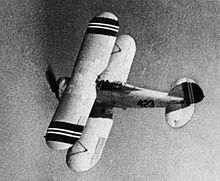
Picture - NoAAS Gloster Gladiator 423 in 1938-1940
The Gladiator was largely replaced in front line RAF service by the Hurricane and Spitfire at the outbreak of the Second World War, though two squadrons were used in the French and Norwegian campaigns. It would, however, see service in more peripheral campaigns during the early years of the Second World War. The classic biplane fighter was also one of Britain's biggest pre-war export successes, seeing service in many countries. The Gloster Gladiator performed reasonably well in limited Finnish service against Soviet fighters during the Winter War, but was found to be outclassed by German fighters in other theatres. Carrier-based Sea Gladiators were more successful, since their slower speed made them more suitable for carrier operations and they were less likely to be facing more modern fighter opposition. In the African theatres against Italian opposition, the Gladiator fared well.
China
In October 1937, the Chinese Central Government ordered 36 Gladiator Is, which were delivered in two crated batches to Guangzhou via Hong Kong. By February 1938 these aircraft had been assembled, and the Chinese pilots familiarized with them. The Gloster Gladiator had its combat début on 24 February 1938, when Chinese Gladiators downed two Japanese A5M Claude navy fighters in the Nanking area, although also losing two Gladiators. Chinese Gladiators scored several more victories over Japanese aircraft between 1938-1940 during the Second Sino-Japanese War. In China Gladiators were used extensively before the start of 1940 by the 28th, 29th and 32nd Squadrons of the 3rd Group. The Chinese pilots considered the Gladiator an excellent fighter in its class. In comparison to its major opponents of the time, such as the Mitsubishi A5M, the Gladiator was only a little slower and superior in all other aspects such as turning rate. However, when newer Japanese aircraft such as the Mitsubishi A6M entered the theatre, the Gladiators' days were numbered. American born Chinese pilots, John "Buffalo" Wong and Arthur Chin became the first Gladiator flying ace and first American fighter ace of the Second World War respectively, and were among a group of 15 Chinese Americans whom formed the original group of American volunteer combat aviators resisting Japanese aggression in China.
The Finnish Winter War
During the Winter War, the Finnish Air Force obtained 30 Mk II fighters from the UK. Ten of the aircraft were donated while the other 20 were bought by the FAF; all were delivered between 18 January and 16 February 1940. The Finnish Gladiators served until 1945, but they were outclassed by the more modern Soviet fighters during the Continuation War. The aircraft was mostly used for reconnaissance from 1941 onwards. The Finnish Air Force obtained 45 aerial victories by 22 pilots with the aircraft type during the Winter War and one victory during the Continuation War. Twelve Gladiators were lost in combat during the Winter War and three during the Continuation War. Two pilots became aces with this aircraft: Oiva Tuominen (6.5 victories with Gladiators) and Paavo Berg (five victories).
Besides the FAF Gladiators, the Swedish Voluntary Air Force, responsible for the air defence of northern Finland during the later part of the war, was also equipped with Gladiator fighters, designated as J8s (Mk Is) and J8As (Mk IIs) by the Swedes. The Flying Regiment F 19 arrived in Finnish Lapland on 10 January 1940, and remained there until the end of the hostilities. It fielded 12 Gladiator Mk II fighters, two of which were lost during the fighting, and five Hawker Hart dive bombers, plus a Raab-Katzenstein RK-26 liaison aircraft and a Junkers F.13 transport aircraft. The aircraft belonged to and were crewed by the Swedish Air Force, but flew with Finnish nationality markings. The Swedish Gladiators scored eight aerial victories and destroyed a further four aircraft on the ground. One concern was expressed when F 19's executive officer Captain Bjx¶rn Bjuggren wrote in his memoirs that the tracer rounds of the Gladiator's machine guns would not ignite the gasoline when penetrating the fuel tanks of Soviet bombers.
The Norwegian Campaign
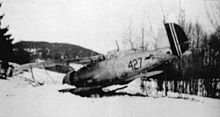
Picture - The sole Norwegian air-to-air Gloster Gladiator loss - Sergeant Pilot Schye's Gladiator 427 on 9 April 1940
The Norwegian Campaign saw both Norwegian and British Gladiators battling the Luftwaffe, with the Norwegian Jagevingen fighting in the defence of Oslo on the first day of the German invasion. Later British Gladiators fought to provide fighter cover for the allied reinforcements sent to the assistance of the Norwegian government.
Jagevingen
The Gladiator pilots of the Norwegian Jagevingen (fighter flight) were based at Fornebu Airport. On 9 April, the first day of the invasion of Norway, the seven serviceable aircraft managed to shoot down five German aircraft: two Messerschmitt Bf 110 fighters, two He 111 bombers and one Fallschirmjx¤ger-laden Ju 52 transport. One Gladiator was shot down during the air battle by the future Experte Helmut Lent, while two were strafed and destroyed while refuelling and rearming at Fornebu airport. The remaining four operational fighters were ordered to land wherever they could away from the base. The Gladiators landed on frozen lakes around Oslo and were abandoned by their pilots, then wrecked by souvenir-hunting civilians.
Picture - The fuselage .303 inch machine guns
Picture - The .303 inch machine guns under each lower wing
Picture - Gloster Gladiator N5628. Damaged by German air attack while based on the frozen lake Lesjaskogsvatnet on 28 April 1940 and abandoned the same day. It eventually sank in May and was recovered in 1968 by a diving team from RAF Cranwell.
263 Squadron
Gladiators were also used by 263 Squadron during the remaining two months of the Norwegian Campaign. The squadron arrived on the carrier HMS Glorious on 24 April, and first operated from an improvised landing strip built by Norwegian volunteers on the frozen lake Lesjaskogsvatnet in Oppland in central southern Norway. After less than a week, all the squadron's aircraft were unserviceable and the squadron was evacuated back to the UK.
Having re-equipped in Britain, 263 Squadron resumed its Gladiator operations in Norway when the squadron returned to the north of Norway on 21 May, flying from Bardufoss airfield near Narvik. At the Narvik front, 263 Squadron was reinforced by Hurricanes of 46 Squadron, which flew into an airstrip at Skx¥nland a few days later. Due to unsuitable ground at Skx¥nland, 46 Squadron also moved to Bardufoss and was operating from this base by 27 May. The squadrons had been ordered to defend the fleet anchorage at Skx¥nland and the military base at Harstad on the island of Hinnx¸ya, as well as the Narvik area after it was recaptured. The action was short but intense before the squadrons, due to the British government's response to the invasion of France, were instructed on 2 June to prepare for evacuation.
By then, 263 Squadron had flown 249 sorties and claimed 26 enemy aircraft destroyed. 263 Squadron's 10 surviving Gladiators landed on HMS Glorious on 7 June. Glorious sailed for home but was intercepted by the German battlecruisers Gneisenau and Scharnhorst. Despite the valiant defence put up by her two escorting destroyers, HMS Acasta and HMS Ardent, she was sunk and along with the aircraft from four squadrons. 263 Squadron lost its CO, S/Ldr John W. Donaldson, and F/Lt Alvin T. Williams along with eight other pilots.
No Norwegian Army Air Service aircraft were able to evacuate westwards before the 10 June surrender of the mainland Norwegian forces. Only the aircraft of the Royal Norwegian Navy Air Service (one M.F.11 and four He 115s) had the range to fly all the way from their last bases in northern Norway to the UK. Two Army Air Service Fokker C.V.Ds did however manage to escape eastwards to Finland before the surrender. Three M.F.11s also flew to Finland, landing on Lake Salmijx¤rvi in Petsamo.
Battle of Britain
The Gloster Gladiator was in operational service with 247 Squadron, stationed in Robourgh, Devon during the Battle of Britain. Although no combat sorties took place at the height of the aerial battles, 247 Squadron Gladiators intercepted a Heinkel He 111 in late October 1940, without result. 239 Squadron, using Gladiators in an army cooperation role, and 804 Squadron Naval Air Squadron, outfitted with Sea Gladiators, were also operational during the Battle of Britain.
Mediterranean and Middle East theatres
In the Mediterranean Theatre during 1940-41, Gladiators saw combat with four Allied air forces: the RAF, Royal Australian Air Force, South African Air Force and Ellinikx Vasilikx Aeroporxa (Royal Greek Air Force) squadrons. These achieved some success against the Italian Regia Aeronautica, which was mainly equipped with Fiat CR.32 and Fiat CR.42 biplanes, and against Luftwaffe bombers. The South African ace Marmaduke "Pat" Pattle (who served with the RAF), claimed 15 kills in Gladiators during the North African and Greek Campaigns, making him the highest-scoring RAF biplane ace of the Second World War.
The 1941 Anglo-Iraqi War was unique in the context of Gloster Gladiators in that the opposing air forces, being the RAF and Royal Iraqi Air Force, both used the Gladiator as their main fighter. Gladiators also saw action against the Vichy French in Syria.
Malta
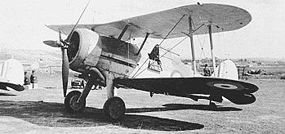
Picture - Faith (serial number N5520), a Gloster Sea Gladiator Mk I, on the ground at an airfield in Malta, in about September 1940. The aircraft has been refitted with a Bristol Mercury engine and three-bladed Hamilton propeller salvaged from a Bristol Blenheim.
One of the best-known campaigns fought by Gladiators was the siege of Malta in 1940. The fighter force defending Malta was, for a period of 10 days, a small force of British-operated Gladiators, the Hal Far Fighter Flight, giving rise to a myth that three aircraft, named Faith, Hope and Charity, formed the entire fighter cover of the island. The aircraft names came into being only after the battle was over. In fact, more than three aircraft were operational, though not always at the same time; others were used for spare parts. No 1435 Flight, which later assumed control of Malta's air defence, took on the names Faith, Hope and Charity for its aircraft upon its reformation as the air defence unit in the Falkland Islands in 1988.
A stock of 18 Sea Gladiators from 802 Naval Air Squadron had been delivered by HMS Glorious, in early 1940. Three were later shipped out to take part in the Norwegian Campaign, and another three were sent to Egypt. By April, Malta was in need of fighter protection and it was decided to form a flight of Gladiators at RAF Hal Far, to be composed of RAF and FAA personnel. Several Sea Gladiators were assembled and test-flown and they became badly needed, since the war started soon thereafter.
The Italian air force units deployed against Malta should had easily defeated the weak defense offered by Gladiators , but their agility and tactics won several engagements, often started with a dive on the S.79 bombers, before the CR.42 and Macchi MC.200 escort could react. On 11 June 1940, a Gladiator damaged a Macchi and on 23 June, another successful battle was fought against S.79s Sparviero and three Macchis. One of the two Gladiators, flown by George Burges, managed to shot down a MC.200./ref; Another successful pilot over Malta was "Timber" Woods who managed to shot down two S.79s and two CR.42s, claiming also the Macchi hit on 11 June and another S.79 (only damaged). Gladiators held the defence against Regia Aeronautica raids and forced Italian fighters to escort bombers and reconnaissance aircraft. Although the Regia Aeronautica had started with a numerical advantage and air superiority, during the summer of 1940, the situation was reversed with Hurricanes being delivered as fast as possible, and gradually taking over the island's air defence. Even if Gladiators had not scored many air victories, they were a very important asset for island's defence..
By June, two of the Gladiators had crashed and two more were assembled. Charity was shot down on 29 July 1940. Its pilot, Flying Officer Peter Hartley, scrambled at 09.45 with fellow pilots F. F. Taylor and Flight Lieutenant William Joseph "Timber" Woods, to intercept a Savoia-Marchetti SM.79 Sparviero, escorted by nine Fiat CR.42s from 23o Gruppo. During a dogfight Tarantino's CR.42 shot down Hartley’s Gladiator (N5519), badly burning him. Woods shot down Antonio Chiodi, commander of the 75a Squadriglia five miles east of Grand Harbour (he was subsequently awarded a posthumous Medaglia d’Oro al Valor Militare, Italy’s highest military award). In May 2009, the remains of Charity and others were the subject of an underwater search by NATO minesweepers.Hope (N5531) was destroyed on the ground by enemy bombing in May 1941. The fate of at least five more Gladiators that saw action over Malta is not as well documented.
North Africa
In North Africa, Gladiators had to face Italian Fiat CR.42s. "The C.R.42 was superior to the Gloster Gladiator, but that was but a paltry success."
The first aerial combat between the biplanes took place on 14 June over Amseat. Tenente Franco Lucchini, of 90 Squadriglia, 10° Gruppo, 4° Stormo, flying a CR.42 from Tobruk, shot down a Gladiator; it was the first claim made against RAF in the desert war. On the afternoon of 24 July, CR.42s and Gladiators clashed over Bardia. A formation of 11 CR.42s from 10° Gruppo, backed by six more from the 13° Gruppo attacked a British formation of nine Blenheims that was attacking Bardia, and was in turn reportedly attacked by 15 Gladiators. The five Gladiators of 33 Squadron claimed four CR.42s destroyed.
On 4 August 1940, Fiat biplanes from 160 Squadriglia of Capitano Duilio Fanali intercepted four Gladiators commanded by Marmaduke "Pat" Pattle (eventually to be one of the top score Allied aces with approximately 50 claims), that were attacking some Breda Ba.65 that were strafing British armoured vehicles. In this occasion, Fiat managed to surprise the Gladiators, shoting down three of them Wykeham Barnes (survived to his Gladiator, lost in the battle) claimed a Breda 65, while Pattle claimed a Ba 65 and a CR.42.
On 8 August 1940, during another dogfight, 14 Gladiators of 80 Squadron attacked by surprise 16 Fiat CR.42s from 9° and 10° Gruppi of 4° Stormo (a Regia Aeronautica elite unit), over Gabr Saleh, well inside the Italian territory. British pilots claimed 13 to 16 confirmed victories and 1 to 7 probables, while losing two Gladiators That battle highlighted the strong points of the Gladiator over the CR.42, especially the radio equipment, which had permitted a coordinated attack, being also crucial for obtaining the initial surprise, and the Gladiators superior low altitude overall performances, including speed and a markedly superior horizontal manoeuvrability over its Italian opponent. British celebrated the victory, while Italians had to admit an hard defeat.. Overall, the few Gladiators and CR.42s clashed with a substantial parity, despite many Italians were already expert due their activity over Spain. Firepower, agility and speed were not far different in any sense, even the engine was comparable; italians had the initial advantage to have fought over Spain while RAF pilots did not, but this was not too important either, as RAF/RAAF pilots had often better fighting tactics. From 1941, monoplanes like Hurricane and MC.200 taken more and more the edge in air combats, relegating biplanes in secondary tasks or ground attack.
Eastern Africa
In Eastern Africa the Gladiators faced the Italian biplane fighters: Fiat CR.32s and CR.42s. The latter, more modern than the Gladiator, was a formidable opponent. On 6 November 1940, in the first hour of the British offensive against Ethiopia, the Fiat CR.42 fighters of the 412a Squadriglia led by Capt. Antonio Raffi shot down five Gloster Gladiators without losses, at the expenses of 1 SAAF Sqn; among the italian pilots there was the ace Mario Visintini, but the real difference was made by tactical situation, as the Gladiators came few at once, and were outnumbered sistematically. On 6 June 1941, the Regia Aeronautica had only two serviceable aircraft: a CR.32 and a CR.42, therefore the air superiority was finally archivied by Gladiators and the Hurricanes. The Gladiator's last air combat with an Italian fighter was on 24 October 1941, with the CR.42 of Tenente Malavolti (or, according to historian Hx¥kan Gustavsson, sottotenente Malavolta). The Italian pilot took off to strafe British airfields at Dabat and Adi Arcai. According to the Italian historian Nico Sgarlato, the CR.42 was intercepted by three Gladiators and managed to shoot down two of them, but was then itself shot down and the pilot killed. Other authors state that Malavolti managed only to fire on the two Gladiators before being shot down.
According to Gustavsson, South African Air Force pilot (no. 47484V) Lieutenant Lancelot Charles Henry "Paddy" Hope, at Dabat airfield, scrambled to intercept the CR.42 (MM7117). Diving on it, he opened fire at 300 yards. Although the Italian pilot took violent evasive action, Hope continued to follow, closing to only 20 yards and firing as the Fiat tried to dive away. There was a brief flicker of flame and the last Italian aircraft to be shot down over East Africa spun into the ground and burst into flames near Ambazzo. Next day, the wreckage was found, the dead pilot still in the cockpit. Hope dropped a message on the Italian positions at Ambazzo: "Tribute to the pilot of the Fiat. He was a brave man. South African Air Force." But operational record books of the Commonwealth units in the area state that they didn’t suffer any losses on this date. The dedication of the posthumous Medaglia d’oro al valor militare states that Malavolti shot down a Gladiator and forced another one to crash land, but was himself shot down by the third Gladiator.
This was the last air-to-air victory in the East African campaign.
Greece
Tension had been building between Greece and Italy since 7 April 1939, when Italian troops occupied Albania. On 27 October 1940, Italy issued an ultimatum to Greece, which was rejected, and the following morning, Italian troops invaded Greece, initiating the Greco-Italian War.
Britain sent help in the form of 80 Squadron, elements of which arrived at Trikkala by 19 November. That same day, the Gladiator debut came in the form of a surprise, intercepting a section of five Italian CR.42s on Coritza, only one of which returned to base. On 27 November, seven Gladiators attacked three Falcos, shooting down the lead aircraft, piloted by Com. Masfaldi, commanding the 364a Squadriglia. On 28 November, the commander of 365a Squadriglia, Com. Graffer, was shot down during a combat where seven aircraft were downed, four of them British. On 3 December, the Gladiators were reinforced with elements from 112 Squadron. The following day, a clash between 20 Gladiators and ten CR.42s resulted in a loss of five, two of them Italians. After a break of two weeks, 80 Sqn returned to operations on 19 December 1940. On 21 December, 20 Gladiators intercepted 15 CR.42 Falcos, shooting down two with nine losses. Over the next few days, several groups of Italian Savoia-Marchetti SM.79 and Savoia-Marchetti SM.81 bombers were also intercepted and victories claimed.
The complete 112 Sqn moved to Eleusis by the end of January 1941, and by the end of the following month, had received 80 Sqn’s Gladiators, after the latter unit had converted to Hawker Hurricanes. On 5 April, German forces invaded Greece and quickly established air superiority. As the Allied troops retreated, Gladiators covered them, before flying to Crete during the last week of April. There No 112 Sqn recorded a few claims over twin-engined aircraft before being evacuated to Egypt during the Battle of Crete.
Anglo-Iraqi War
The Royal Iraqi Air Force (RoIAF) had, since Iraq was granted independence in 1932, been trained and equipped by the British. One result of this was the dominance of British-built aircraft in the RoIAF inventory. In 1941, the sole RoIAF single-purpose fighter squadron, No. 4 Squadron consisted of seven operational Gloster Gladiators at Rashid Air Base.
After a pre-emptive RAF attack from RAF Habbaniya against blockading Iraqi forces, Iraqi Gladiators took part in attacks on the British air base, strafing it ineffectively on 2 May. Although much of the RoIAF was destroyed in the air or on the ground in the following days, the Iraqi Gladiators kept flying until the end of the war, carrying out strafing attacks on A Company of 1 Battalion The Essex Regiment on the outskirts of Baghdad on 30 May.
Before the outbreak of hostilities in Iraq, the 4th Service Training School at RAF Habbaniya operated three old Gladiators as officers' runabouts. With the increased tension, the base was reinforced with another six Gladiators on 19 April, flying in from Egypt. During the early part of the war the nine Gladiators flew numerous sorties against air and ground targets, taking off from the base' polo field. The Gladiator force in Iraq was further reinforced when, on 11 May, another five aircraft arrived, this time from 94 Squadron in Ismax¯lia on the Suez Canal. A last resupply of Gladiators came on 17 May in the form of four more 94 Squadron machines.
During the fighting, the sole Gladiator-on-Gladiator kill occurred on 5 May, when Plt. Off. Watson of the Fighter Flight shot down an Iraqi Gladiator over Baqubah during a bomber escort mission. The Iraqi Gladiators' only claim during the war was a Vickers Wellington bomber shared with ground fire on 4 May.
Immediately after launching his coup against King Faisal II in early April 1941, Prime Minister Rashid Ali al-Gaylani approached Germany and Italy for help in repelling any British counter-measures. In response, the Germans assembled a Luftwaffe task force under Iraqi colours called Fliegerfx¼hrer Irak ("Flyer Command Iraq") which from 14 May operated out of Mosul. Before this force collapsed due to lack of supplies, replacements, quality fuel and aggressive RAF attacks, two Gladiators fought a pair of Me 110s over Rashid Airfield at Baghdad on 17 May. Both German machines were swiftly shot down.
The Iraqis continued to use Gladiators until 1949 for ground attack missions against the Kurds.
Syria
After the end of the Iraq fighting the British decided to invade Vichy French-controlled Syria to prevent the area from falling under direct German control. The French in Syria had supported the Iraqi rebellion materially and allowed Luftwaffe aircraft to use their airfields for operations over Iraq. The month-long Syria-Lebanon Campaign in June-July 1941 saw heavy fighting both in the air and on land, until the Vichy French authorities in Syria surrendered on 12 July 1941. In one encounter between the Royal Air Force and the Vichy French Air Force on 15 June 1941, six Gloster Gladiators were jumped by an equal number of Dewoitine D.520 monoplane fighter aircraft. In a confused battle, both sides lost one aircraft shot down and one severely damaged. French fighter ace Pierre Le Gloan shot down the Gladiator for his 15th confirmed kill. Le Gloan himself had to crash land his damaged D.520 at his own air base.
As late as mid-1941, the RAF Chief-of-Air Staff offered 21 Gloster Gladiators gathered from various meteorological and communications flights in the Middle East, as well as five from a Free French unit, to AOC Singapore in order to strengthen the colony's defences against the emerging Japanese threat. The offer was turned down and later reinforcements consisted of Hawker Hurricanes.
Operations elsewhere
Belgian Gladiators suffered heavy losses to the Germans in 1940, with all 15 operational aircraft lost, while only managing to damage two German aircraft.
The Irish Air Corps was supplied with four Gladiators on 9 March 1939. On 29 December 1940, two Irish Gladiators were scrambled from Baldonnel to intercept a German Ju 88 flying over Dublin on a photographic reconnaissance mission, but were unable to make contact. Although unable to intercept any intruding aircraft, the Irish Gladiators shot down several British barrage balloons that had broken from their moorings. For a short time in 1940, an order was given to Irish fighter pilots to use their aircraft to block the runways of airfields. They were then to use rifles and shoot at any invaders. Irish Gladiators also overflew the site of the sinking of the liner SS Athenia in 1939 and offered the help of the Irish military. The flight was fired upon by Royal Navy ships in attendance, consequently, the Irish Gladiators withdrew.
The Luftwaffe used captured Latvian Gladiators as glider tugs with Ergx¤nzungsgruppe (S) 1 from Langendiebach near Hanau during 1942-3.
After becoming obsolete, RAF Gladiators carried out non-combat tasks such as meteorological work.
Variants
SS.37 Prototype. Gladiator I Version powered by a single 840 hp (627 kW) Bristol Mercury IX air-cooled radial piston engine. The aircraft was designated J 8 in Swedish Air Force service. Delivered 1937-38, 378 built. Gladiator II Version powered by a single Bristol Mercury VIIIA air-cooled radial piston engine. The aircraft was designated J 8A in Swedish Air Force service, 270 built. Sea Gladiator Interim Single-seat fighter biplane for the Royal Navy, 38 built. Fitted with arrestor hooks. Serial numbers: N2265 - N2302. Sea Gladiator Single-seat fighter biplane for the Royal Navy, 60 built. Fitted with arrestor hooks and provision for dinghy stowage. Serial numbers: N5500 - N5549 and N5565 - N5574.
Operators
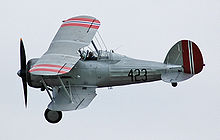
Picture - Gladiator in pre-Second World War RNoAF colours
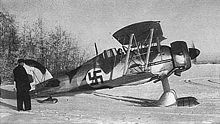
Picture - Swedish Voluntary Air Force Gladiator fighter from the air squadron F 19, with Finnish Air Force markings
Australia
Belgium
China
Egypt
Free France
Finland
Germany (small numbers)
Greece
Iraq
Ireland
Latvia
Lithuania
Norway
Portugal
Romania
South Africa
Soviet Union
Sweden
United Kingdom
Survivors
Gladiators have been preserved at the Shuttleworth Collection, Fighter Collection at Duxford, Gloucestershire Aviation Collection (in Bedfordshire, UK), the National War Museum, Malta and the RAF Museum (in Hendon and Cosford, UK). One Swedish Gladiator Mk I is preserved in Winter War markings at the Swedish Air Force Museum in Malmen, just outside of Linkx¶ping, Sweden.
Malta
The fuselage of the only surviving Gladiator from the Hal Far Fighter Flight (N5520), later called Faith, was presented to the people of Malta in 1943. The fuselage remains are displayed in the War Museum at Fort St Elmo, Valletta. Research on the airframe has indicated that it incorporates parts of at least one other Gladiator. Malta's Aviation Museum has been trying since at least 2005 to obtain possession of the Gladiator remains from the War Museum which, it claimed, was lacking sufficient security for valuable heritage exhibits. In its Air Battle of Malta Memorial Hangar at Ta' Qali, the Aviation Museum had demonstrated superior expertise in aircraft restoration and had managed to acquire "a set of wings and other parts for the Gladiator". This request was reinforced in November 2008 by a newspaper article which stated "the aircraft is in a very bad state and now approaching the point of no repair".
Quotations
Specifications (Gloster Gladiator Mk I)
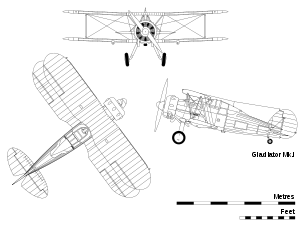
Picture - Orthographic projection of the Gladiator Mk.I
Data from Gloster Aircraft since 1917
General characteristics
Crew: 1
Length: 27 ft 5 in (8.36 m)
Wingspan: 32 ft 3 in (9.83 m)
Height: 11 ft 9 in (3.58 m)
Wing area: 323 ft² (30.0 m²)
Empty weight: 3,217 lb (1,462 kg)
Loaded weight: 4,594 lb (2,088 kg)
Powerplant: 1x— Bristol Mercury IX radial engine, 830 hp (619 kW)
Performance
Maximum speed: 253 mph (220 knots, 407 km/h) at 14,500 ft (4,400 m)
Cruise speed: 210 mph
Stall speed: 53 mph (46 knots, 85 km/h)
Endurance: 2 hours
Service ceiling: 32,800 ft (10,000 m)
Rate of climb: 2,300 ft/min (11.7 m/s)
Climb to 10,000 ft (3,050 m): 4.75 min
Armament
Guns:
Initially; Two synchronised .303 in Vickers machine guns in fuselage sides, two .303 in Lewis machine guns; one beneath each lower wing.
Later aircraft; Four Browning machine guns; 2 synchronised guns in fuselage sides and one beneath each lower wing.
In at least some Sea Gladiators, provision existed for a pair of Brownings to be fitted under the upper wings as well, bringing the total to six. Official service release trials were not completed before the Sea Gladiators were replaced by later types - but some upper wing Brownings may have been fitted in the field, in particular in Malta.
F. H. Maynard
John H. Lapsley
Related development
Gloster Gauntlet
Comparable aircraft
Avia B-534
Bristol Bulldog
Fiat CR.32
Fiat CR.42
Grumman F3F
Polikarpov I-15
Polikarpov I-153
Related lists
List of aircraft of the Royal Air Force
List of aircraft of the Fleet Air Arm
Bibliography
Ministry of Information. The Air Battle of Malta, The Official Account of the RAF in Malta, June 1940 to November 1942. London: His Majesty's Stationery Office, 1944.
Barber, Mark. The British Fleet Air Arm in World War II. Oxford, UK: Osprey Publishing, 2008. ISBN 978-1-84603-283-7.
Belcarz, Bartłomiej and Robert Pęczkowski. Gloster Gladiator, Monografie Lotnicze 24 (in Polish). Gdańsk, Poland: AJ-Press, 1996. ISBN 83-86208-34-1.
Bierman, John and Colin Smith. The Battle of Alamein: Turning Point, World War II. New York: Viking, 2002. ISBN 0-670-03040-6.
Crawford, Alex. Gloster Gladiator. Redbourn, UK: Mushroom Model Publications, 2002. ISBN 83-916327-0-9.
Cull, Brian and Paul Sortehaug. Hurricanes over Singapore - RAF, RNZAF and NEI Fighters in Action against the Japanese over the Island and the Netherlands East Indies, 1942. London, UK: Grub Street, 2004. ISBN 1-904010-80-6.
Emiliani, Angelo, Giuseppe F. Ghergo and Achille Vigna. Regia Aeronautica: I Fronti Africani(in Italian). Parma: Ermanno Albertelli editore, 1979.
Fodor, Denis J. The Neutrals (Time-Life World War II Series). Des Moines, Iowa: Time-Life Books, 1982. ISBN 0-80943-431-8.
Goulding, James and Robert Jones. "Gladiator, Gauntlet, Fury, Demon".Camouflage & Markings: RAF Fighter Command Northern Europe, 1936 to 1945. London: Ducimus Books Ltd., 1971.
Green, William and Gordon Swanborough. WW2 Aircraft Fact Files: RAF Fighters, Part 1. London: Macdonald and Jane's, 1978. ISBN 0-354-01090-5.
Gustavsson, Hx¥kan and Ludovico Slongo. Desert Prelude - Early Clashes - June-November 1940. Hampshire UK, MMP/STRATUS White Star No 9107, 2010. ISBN978-83-89450-42-4.
Harrison, W.A. Gloster Gladiator in Action. Carrollton, Texas: Squadron Signal, 2003. ISBN 0-89747-450-3.
Kennedy, Michael. Guarding Neutral Ireland. Dublin: Four Courts Press, 2008. ISBN 978-1846820977.
Keskinen, Kalevi and Kari Stenman. Hurricane & Gladiator (Suomen Ilmavoimien Historia 25) (bilingual Finnish/English). Espoo, Finland: Kari Stenman, 2005. ISBN 952-99432-0-2.
Jackson, Robert. The Forgotten Aces: The Story of the Unsung Heroes of World War II. London: Sphere Books, 1989. ISBN 978-0747403104.
James, Derek N. Gloster Aircraft since 1917. London:Putnam, 1971. ISBN 0 370 00084 6.
Ketley, Barry (1999). French Aces of World War 2. Oxford: Osprey Publishing. ISBN 978-1-85532-898-3.
Lumsden, Alec. "On Silver Wings - Part 19". Aeroplane Monthly, April 1992, Vol. 20 No, 4, Issue 228. ISSN 0143-7240. pp. 8-14.
Lyman, Robert. Iraq 1941: The Battles for Basra, Habbniya, Fallujah and Baghdad. Oxford, UK: Osprey Publishing, 2006. ISBN 1-84176-991-6.
Mason, Francis K. British Fighters of World War Two, Volume One. Windsor, Berkshire, UK: Hilton Lacy Publishers Ltd., 1969. ISBN 0-85064-012-1.
Mason, Francis K. The Gloster Gladiator. London: Macdonald, 1964.
Mason, Francis K. The Gloster Gladiator. Leatherhead, UK: Profile Publications, 1966.
Matricardi, Paolo . Aerei Militari: Caccie e Ricognitori (in Italian). Milano: Mondadori Electa, 2006
Neulen, Hans Werner. In the Skies of Europe. Ramsbury, Marlborough, UK: The Crowood Press, 2000. ISBN 1-86126-799-1.
Patri, Salvatore.L' ultimo Sparviero dell'impero Italiano: A.O.I. 1940-1941 (in Italian). Roma: IBN editore 2006
Pacco, John. "Gloster Gladiator Mk I" Belgisch Leger/Armee Belge: Het Militair Vliegwezen/l'Aeronautique Militare 1930-1940 (bilingual French/Dutch). Aartselaar, Belgium: J.P. Publications, 2003, pp. 56-59. ISBN 90-801136-6-2.
Poolman, Kenneth. Faith, Hope and Charity: Three Biplanes Against an Air Force. London: William Kimber and Co. Ltd., 1954. (First pocket edition in 1958.)
Rawlings, John D.R. Fighter Squadrons of the RAF and Their Aircraft. London: Macdonald and Jane's, 1969. (Second edition 1976.) ISBN 0-354-01028-X.
Rimell, Ray. Battle of Britain Aircraft. Hemel Hempstead, Hertfordshire, UK: Argus Books, 1990. ISBN 1-85486-014-3.
Sgarlato, Nico. Fiat CR.42 (in Italian). Parma: Delta Editrice, 2005.
Shores, Christopher and Brian Cull with Nicola Malizia. Malta: The Hurricane Years. London: Grub Street, 1987. ISBN 0-948817-06-2
Spencer, Tom. Gloster Gladiator (Warpaint Series No.37). Luton, UK: Warpaint Books, 2003. ISSN 1361-0369.
Thetford, Owen. Aircraft of the Royal Air Force 1918-57. London:Putnam, 1957.
Thetford, Owen. "On Silver Wings - Part 20". Aeroplane Monthly, May 1992. Vol. 20 No. 5. Issue 229. ISSN 0143-7240. pp. 8-15.
Thomas, Andrew. Gloster Gladiator Aces. Botley, UK: Osprey Publishing, 2002. ISBN 1-84176-289-X.
Thomas, Andrew. "Oriental Gladiators: The combat debut for the Gloster biplane." Air Enthusiast #121, January/February 2006, pp. 73-75.
Williams, Anthony G. and Dr. Emmanuel Gustin. Flying Guns: World War II. Ramsbury, Marlborough, UK: The Crowood Press, 2003. ISBN 978-1-84037-227-4.
Zbiegniewski, Andre R. 112 Sqn "Shark Squadron", 1939-1941 (bi-lingual Polish/English text). Lublin, Poland: Oficyna Wydawnicza Kagero, 2003. ISBN 83-89088-55-X.
Living Warbirds: The best warbirds DVD series.
Source: WikiPedia